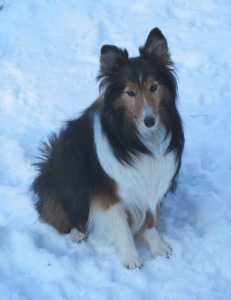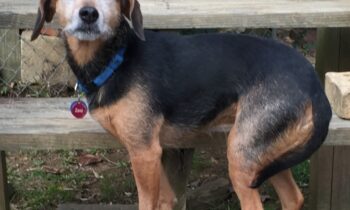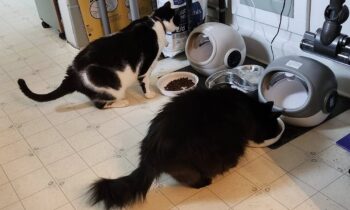
It’s winter! Our dogs still need exercise, but it’s cold and dark outside. Even in our back yards, there’s little fun to be had for the warmth-loving canine. Many of our dogs (especially the small or lightly furred ones) take one look at snow and ice and want to come back inside. What to do?
Here are some suggestions for indoor games for dogs.
Hide and Seek
This game is fun if you have a houseful of family and friends, but it’s also possible to play if there’s just you and the dog. If you have help, ask one family member to keep the dog behind a closed door or on a leash until the person or people hiding have found their spots. Each hidden person carries a supply of treats. It helps if the dog is hungry. (Don’t play this game right after meals.) The person with the dog counts to a given number, then alerts the hiders that the dog is coming and releases the dog.
Once the dog knows the game, there should be no hesitation on her part to start looking, but when she is a novice at the sport, make it easy for her to succeed. Instruct each hiding participant to do what they feel might encourage the dog to look for them—maybe stomping on the floor, or singing a song? When the dog arrives at their hiding spot, make a big deal of it! Shower her with treats and praise.
Eventually, if the dog likes this game, she will get really good at it. When that happens, up the difficulty. Do you think she can hear where people will hide because of the noises they make getting there? Play some loud music near where the dog is—not enough to hurt her ears, just enough to mask the sounds the hiders make. When the music stops, the hunt is on.
Do you think the dog is tracking the hiders? Is she following their scents through the house? Experiment with laying false trails! Throw a sweatshirt or a shoe off to one side as you race through the house to your hiding place. Will that stop her? Probably not, because something that simply smells like you is nowhere near as rewarding as you yourself, showering the dog with praise and treats! Which family member does the dog always find first? See if you can figure out why!
When you’re alone, you can blindfold the dog. Yes, you can. Wrap around her head an old soft towel or an old sweater. Winter scarves work well, too, but only if you’re sure she won’t chew them up before she tries to find you. The idea of the blindfold is to give you time to hide while the dog paws off the eye covering. The blindfold is temporary and is not meant to be worn for more than the first few minutes of the game. Do not cover your dog’s eyes if she is standing anywhere near stairs or if she might be in any physical jeopardy from temporarily not being able to see. Be safe!

Hide and Call
This is a more advanced version of Hide and Seek. It lets you practice recalls—coming when called—in an informal setting. Set up the game by having one person hold the dog on a leash or behind a closed door while the game’s hiders go to their secret spots. Each hider is assigned a number. The dog’s “monitor”— the person holding the dog by a leash (removed for the racing around the house searching for family members) or behind a closed door —yells out, “Number One!” The person assigned that number, from his or her hiding place, then calls the dog. Use your standard informal coming-when-called cue word, like “Here!” Call loudly but in a friendly, upbeat manner. (Practice ahead of time with young kids to be sure they get it right.)
The dog races to find the person who called. (If other hiding persons are discovered first, they should turn their backs to the dog and not acknowledge her in any way—no treats, no praise, no interaction.) When dog arrives at the person who called her, repeat the cue in praise: “Good here!” Make a big fuss over the dog; take her collar in one hand, feed her treats with the other hand. If you’re working with children, have an adult stand with the child. Let the adult take the collar and feed the treats while the child praises, too. You’ll keep the child safe from an overenthusiastic dog because the hands interacting with the dog will be the adult’s, although the voice calling the dog was the child’s.
The dog’s monitor follows the dog from person to hidden person. When the dog has successfully found the person assigned as Number One, the dog’s monitor calls out, “Number Two!” so the next in line will know it’s his or her turn to call the dog.
When first playing this more complicated version of the game, the dog may become confused. Remember to instruct all players, anytime the dog comes to them when it is not their turn, to ignore the dog and refuse to interact. Should the dog continue to try to interact, the dog’s monitor could reattach the leash and walk the dog to another part of the house, possibly closer to the next caller. The monitor’s job is to make it as easy as possible for the dog to succeed.
Name and Call
The goal of the Name and Call game is to help your dog learn to identify family members and friends by name. Wouldn’t it be great to be able to tell your dog, “Go see Grandma,” and to have her trot directly to Grandmother and wait for further instructions? This game can be a start!
You must first decide what you want to call each family member . . . to the dog!
Kids are easy: you’ll probably use the child’s name or nickname.
Parents are more difficult. Do you want the dog to know you as “Mom” or “Dad”? How do the grandparents feel about what the dog “calls” them? Yes, you’ll probably need to have a family meeting! Keep in mind that your dog is most likely to recognize short, uncomplicated names. She will probably not be able to learn “Great Aunt Mabel Belle” as easily as she might learn “Auntie M.” But your aunt may not play the game if she doesn’t like “what the dog calls her.” So be careful—arrive at a consensus and stick to the names you’ve chosen.
Play with just two family members at first—one to hold the dog, one to call the dog.
The family member holding the dog says enthusiastically, “Go find Dad!” and releases the dog.
Dad, about six to ten feet away, calls the dog—“Here!”—while showing treats and encouraging the dog with body language.
The dog runs to Dad, Dad takes the dog gently by her collar, Dad gives the dog treats and high praise. The other family member praises the dog verbally—“Good Dad! You found Dad!”—while Dad puts the leash back on the dog.
Repeat.
As the dog begins to understand, the dog’s monitor and the person whose name is being taught can separate farther, as long as the dog can see the person calling her. Later, this game can become more and more like Hide and Seek as the person calling moves around a corner, to the top of the stairs, and eventually into another room. The dog’s monitor always encourages the dog to “Go find Dad,” and Dad, when found, always responds with high praise and great treats.
When the dog has learned one family member’s “name” and how to “find him,” it’s time to teach the dog the name of another family member or friend. Do not confuse the issue for the dog by having the original person (“Dad,” in my example) present when you start to train a second person’s name. You are training, not testing. Keep all “named” family members and friends out of the area when you are training to add a new name to to the dog’s repertoire. Make it easy for the dog!
Much later, when you are absolutely positive your dog knows your named family members, you may be ready to give her a choice—two named persons standing ten feet apart. But, again, you’re still training, not testing. Give the dog all the help you can to get it right. If the dog’s monitor says, “Go find Dad,” then Dad is the one whose body language and facial expression should welcome the dog. The “other” person in the room should face away from the dog, offering no encouragement whatsoever—the “other” person shouldn’t even be carrying treats! Additional direction from the dog’s monitor (whoever’s holding her on the leash) might include a full arm gesture with pointing hand to help aim the dog’s interest to the correct choice of person with two named persons in the room. No orders, just cues.
Does the dog fail? No, never. The dog may not do what you hope she’ll do but she has not failed. No recriminations and certainly no “punishment”! Stop and figure out what might have gone wrong. Was the dog bored with the game? Did you put too much pressure on her? Were you showing signs of frustration that the dog might have perceived? Is she not having fun? Back up to the beginning and start again, because the dog has shown you she’s not ready to go further with her training . . . yet.



